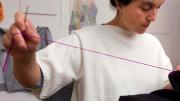When Celia Pym ’01 was 28, her great uncle died, and her father, going through the old man’s things, found a sweater he thought she would like. Pym was just starting out as a professional artist, feeling her way toward a focus on textiles and knitting. The sweater was white and handknit, and completely worn out in the forearms. In some places, the wool had thinned to a fragile web of loops. “And as soon as I held it,” she says, “I could see, written into this damage, my Uncle Roly sitting in his armchair, leaning on his drawing board where he would draw every day.” A painter, he had lived with her family at their home in Kent, south of London.
But when she looked closer, Pym noticed something else: numerous previous repairs, done by her great aunt Elizabeth, Roly’s sister, who also lived with the family and had died several years earlier. “She was never one to tell you she loved you or squeeze your cheek—she would just show you her garden or explain about making a cake or pick you up from school,” Pym says. “There was a generous presence to her, and I was completely moved to see these darns in Roly’s sweater. They were so precisely her….So, her absence was written into this damage too.” Pym mended the holes, choosing a blue yarn, to contrast with her aunt’s white darns—to keep visible what was missing.
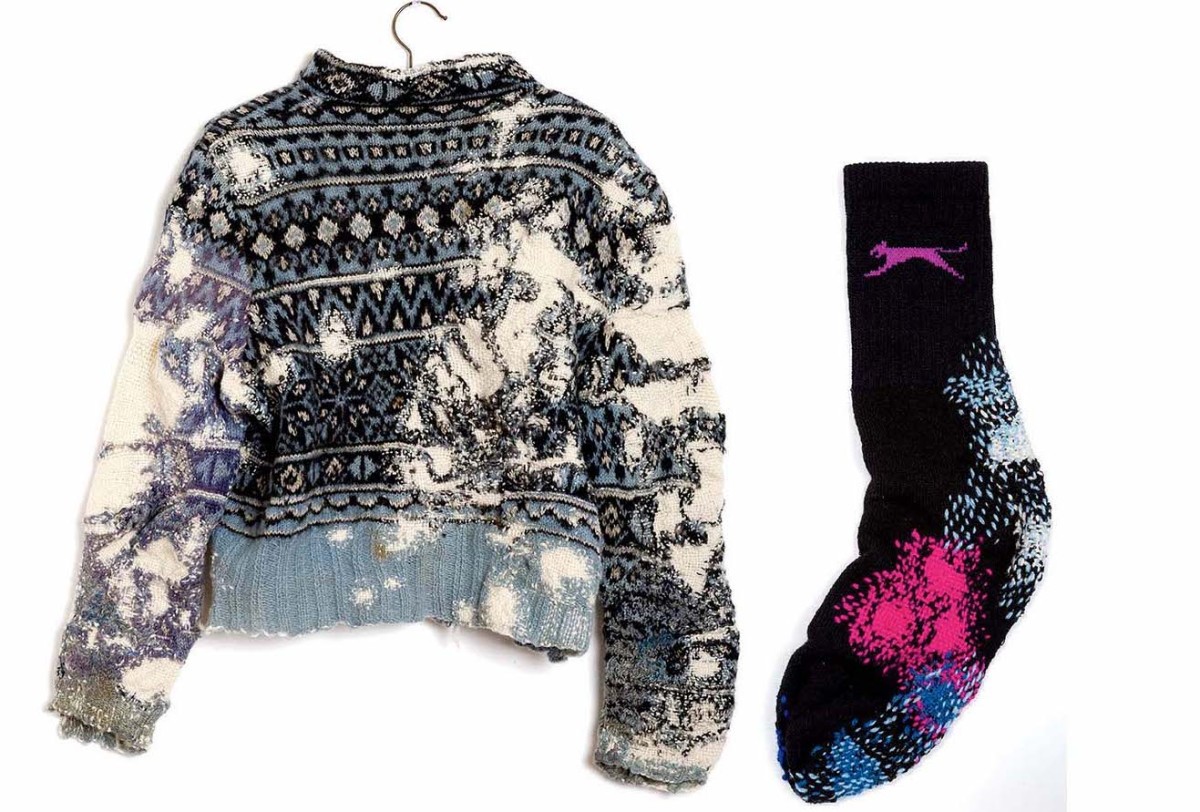
Celia Pym mends holes in other people’s clothes, from athletic socks to a Norwegian fisherman’s tattered sweater.
Photograph courtesy of Celia Pym
This has been Pym’s artistic practice ever since: mending holes in other people’s clothes, exploring what’s revealed by damage and repair. “One reason it’s good seeing what you’ve mended is that, once things change, once damage creeps in, it’s very hard to return to the original,” she says. “To make it something new, but different—that’s the stronger move.” Early on, she repaired a Norwegian fisherman’s sweater, given to her by textile artist Annemor Sundbø; Pym’s darning washes across the tattered blue-and-gray garment like a tide, filling every empty space with white. One of her recent pieces is a black wool dress and jacket that belonged to the actress Vivien Leigh. The outfit was sent to Pym by film director James Ivory, who’d been keeping it for Leigh when she died in 1967 (Ivory is a longtime friend of Pym’s father, John Pym, a film journalist and author). In Ivory’s attic, moths had eaten away at the fabric for decades. “But it’s a beautiful fiber,” Pym says—handknit by women doing piecework for the Women’s Home Industries, founded after World War II to help rebuild the British economy. Pym’s white stitching stretches the length of one side of the dress and covers much of the jacket’s back: dense patches that spiderweb out into tiny cracks.
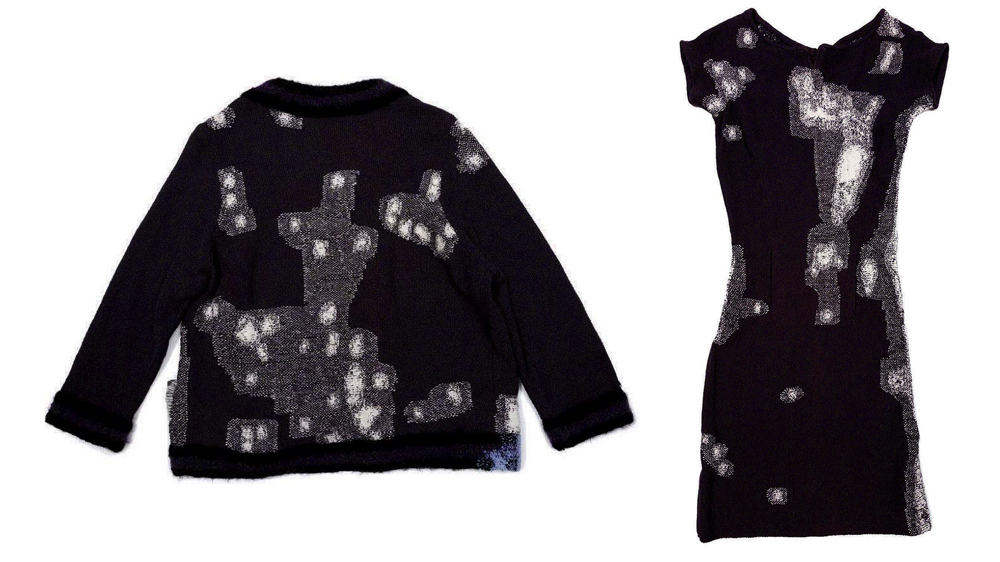
A moth-eaten black jacket and dress—now mended—that once belonged to the actress Vivien Leigh
Photograph courtesy of Celia Pym
But the heart of Pym’s artwork is more in the everyday than the exalted. After mending Roly’s sweater, she began holding public events in which she invited people to bring their own garments for repair. They showed up with sweaters, scarves, gloves, coats, jeans, socks, and even backpacks—items that were moth-eaten or fire-damaged or just worn out. In an art gallery or a community center, Pym would set up a desk with brightly colored yarns, “and we’d negotiate,” she says. “It’s a bit like going to the doctor or the nurse—you have a consultation.” People would share memories of the clothing they’d brought; Pym would find further stories tucked into the fabric.
Afterward, she would bring the broken garments back to her studio in London, where she’d work on them for weeks or months, using the simplest of tools: scissors, sewing needles, knitting needles. Eventually, often at the end of an exhibition’s run—Pym has shown her work at galleries and museums across the United Kingdom and Europe, as well as in the United States and Japan—she’d return the repaired clothing to its owners. That’s true of nearly all Pym’s artwork: she keeps photographs of the mending process and finished pieces, but the garments themselves “always go back.” Currently, she is working on a project at a stately home in Leeds open to the public, mending clothes that belong to the staff: “the gardeners and housekeepers, the guy who winds the clocks, people who chauffeur visitors around.” The pieces will be on display there beginning in March, along with portraits of their owners wearing them.
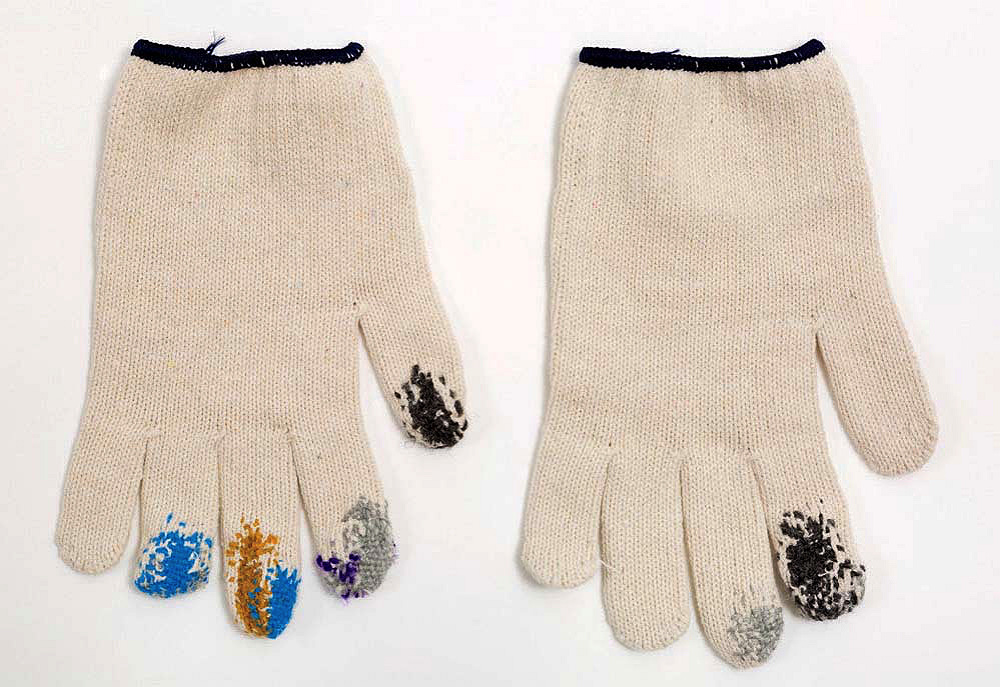
“Darned Fingertips,” one of Pym's mending projects, made from Japanese gardening gloves
Photograph courtesy of Celia Pym
Pym never intended knitting as an artistic career. At Harvard, her concentration was sculpture; knitting was a warm-up exercise she’d do to get her hands moving. But then something shifted—a project knitting red yarn on the MBTA Red Line became her senior thesis—and after graduation, she took a Gardner Scholarship to Japan, traveling the country, knitting every day, in parks, on beaches, in shop windows, the pace of the journey determined by the pace of her knitting. The trip was transformative. She returned to the U.K. with a mass of blue knitting (a nod to the Japanese tradition of indigo dyeing), and was invited to participate in a show in London, which led to a graduate degree in constructed textiles at the Royal College of Art (where she now also teaches).
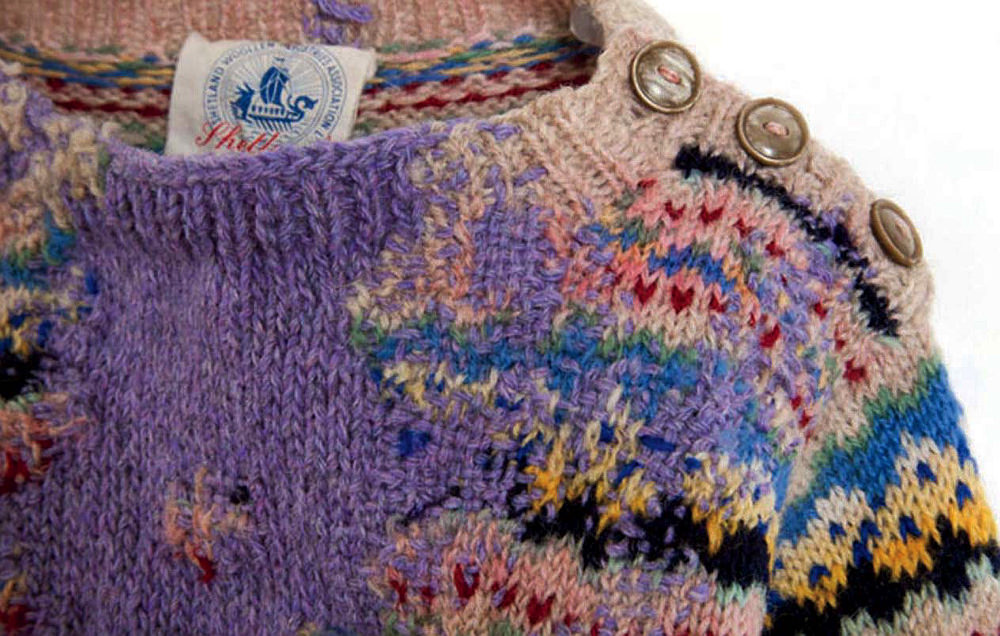
“Hope’s Sweater, 1951”
Photograph courtesy of Celia Pym
It’s not a leap to see shades of Pym’s sculpture studies in her ideas about clothing and the human body, but her artwork also draws on a very different might-have-been. For several years after college, she worked as a nurse’s assistant on a stroke ward in a small hospital; later, she even earned a nursing degree, imagining a career in both. “Which wasn’t physically possible,” she says, but it did lead to an eccentric and pivotal artistic residency in the dissecting room at Kings College London. Partnering with the school’s head of anatomy, she spent a semester there in 2014, her mending desk set up in a corner while medical students examined human bodies. “It was almost like a way of modeling care,” she says. “I would mend things for them, with the thought that they’re training to be menders, carers, not just knowledge banks of anatomy.” Sometimes students would find identifying marks on the bodies—tattoos, scars, evidence of past surgeries. “So they’d be getting clues about the person’s life,” Pym says, “which is often the way I feel about mending. You put your hand inside the sleeve of someone’s sweater, and you don’t know this person, but you can smell them, you’re close to a fabric that’s touched them. Wool, cotton—these materials absorb some of us, take on our shape. They are like second skins, which was something I thought about a lot when I was in the dissecting room.”
Recently, amid the UK’s strict COVID lockdowns, Pym turned to another everyday material, and one more overtly sculptural: paper bags for groceries and takeout. “You’d get really excited about every trip to the grocery store,” Pym says, and she noticed she was tearing the bags wide open whenever she got home. What if she stitched them together again with colorful yarns, making them new and different? Both softer and more robust, no longer a throwaway item, but something more precious. “I see holes everywhere now,” she says. And the possibility for repair.
